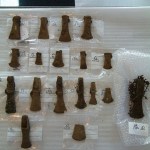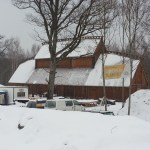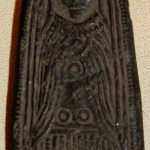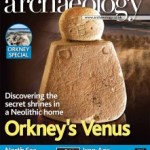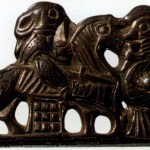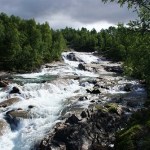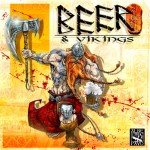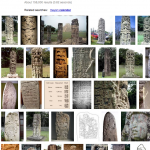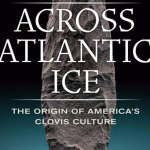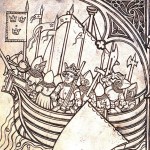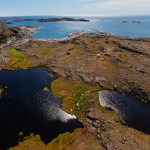archaeology
My Linnaeus University colleague and trätobroder (debate adversary) of many years, Cornelius Holtorf, published a book in 2007 under the title Archaeology is a Brand. That is certainly a possible way of looking at it. But preparing a talk on internet archaeology, I made a little discovery. Look at what this brand appears to be worth! There is hardly any demand for the words ”archaeology” or ”archeology” as internet domain names.
archaeology.com
undeveloped
archeology.com
undeveloped
archaeology.org
US paper mag
archeology.org
undeveloped
archaeology.net
small NYC web design firm…
My paper on the re-use of Late Iron Age picture stones during that same period (mainly in late male graves) has been published in English and Swedish parallel versions of Gotländskt Arkiv 2012. That's the annual of the Gotland County Museum. Have a look! Questions and comments are most welcome.
Current Archaeology #276 (March) has a feature on excavations for a new container port that's being built at Stanford Wharf near the mouth of the Thames. The Iron Age and Roman Period archaeology proved quite lovely, with waterlogged salt-making sites, remains of a boat house, loads of pottery, even waste from garum fish-sauce making. But the reason for the excavation is also interesting.
Consider the terms “nature reserve” and “nature preserve”. Most of us probably think of them as bits of particularly fine nature that are fenced in and preserved. But at Stanford Wharf much of the…
The Midgardsenteret visitors' centre at Borre invited me to give a talk about my Östergötland elite settlement project. This went well, with a sizeable and appreciative audience last night. One gentleman explained that they had all learned Swedish from watching kids' TV when they were little. Today I went on a royal Late Iron Age binge.
This is Vestfold, home of the Norwegian branch of the Ynglingar dynasty, with sites like Oseberg, Gokstad, Kaupang, Huseby, Gulli – and Borre. The ancient cemetery starts right outside the main entrance to Midgardsenteret with some low mounds of respectable…
Another one of the rare production dies for 6/7/8th century gold foil figures has come to light, again on Zealand! This is an unusual design depicting a lady from the front. She's wearing a long dress, a cloak and two bead strings. She seems to be cupping her hands around a ring at her abdomen. The rings on her dress hem are quite odd. Parallels to the general motif and design are known from Eketorp on Öland (a foil) and Sättuna in Östergötland (a die). Congratulations to detectorist Hans, and thanks for doing other folks with an interest in the past a big favour!
Update 4 Feb: Aard regular…
A teenage boy carved this imagery, along with some lines of runic script copied from a book, onto a Viking Period whetstone he found in a Sigtuna spoil dump.
Read it all on-line, Open Access!
Lars Larsson presents some Late Palaeolithic antler artefacts from Scania.
Olle Andersson makes and tests lots and lots of spearheads to investigate how the Iron Age ones found at Uppåkra got all bent and curled up.
Helmer Gustavson announces the confession of the man who faked the Sigtuna runic whetstone, and looks at how scholars have dealt with this strange object in their writings.
Timo Salminen…
When I was an undergrad in 1990 we were taught that all six periods of the Scandinavian Bronze Age were 200 (or in one case 300) years long. The most recent radiocarbon work shows that they all had different lengths and were more likely 130-280 years long. And the periods with the most abundant metalwork finds, II and V, are the two shortest. So their previously known status as metal-rich eras looks even more pronounced now, and the intervening periods look even poorer.
Per. I. 1700-1500 cal BC (200 yrs)
Per. II. 1500-1330 (170 yrs)
Per. III. 1330-1100 (230 yrs)
Per. IV. 1100-950/20 (165 yrs…
Most prosperous countries have legislation for what kinds of archaeological finds a citizen has to hand in to the authorities. In Denmark, still using a Medieval term, such finds are termed danefae, "property of the dead". And here is Danish TV4's list of the top-10 such finds of 2012. All but one of them have been handed in by detectorists, and two by Swedish detectorists operating in Denmark because of Sweden's restrictive rules!
It wouldn't really be worthwhile to make a top-10 like this for Sweden, as the pretty gold & silver metalwork they concentrate on in the program is usually…
Current Archaeology #273 (Dec) has an interesting feature on an 18th century ship of the line found hidden as a construction kit under the floor of a workshop at a naval dockyard in Kent. The timbers were re-used, but not in an economically or structurally rational way. Instead the greatest possible amount of ship's timbers had been crammed in under the floor. Markings on them and historical records identify the ship as the HMS Namur, famous in its time for the battles it fought. It was launched in 1756 and broken up in 1833-34.
Investigators have put forward an interesting suggestion as to…
Hot on the heels of the hapless Science Publishing Group, I have received solicitation spam from another dodgy OA publisher, Hindawi Publishing in Cairo, with another odd on-line archaeology journal.
The Journal of Archaeology has 71 academics on its editorial board. And a strangely generic name. What it doesn't have is any published papers yet, after months on-line, or an editor-in-chief. So I wrote to some board members at European universities, and they replied that they thought the journal was probably legit, though they weren't exactly sure. "The lack of published papers and low…
Etymologically speaking, ”valkyrie” means ”chooser of the slain”. The job of these supernatural shield maidens in Norse mythology is to select who dies on the battlefield and guide their souls to Odin's manor, where they will spend the afterlife training for the Twilight of the Gods, the final battle against the forces of chaos. After each day's combat training, a mead-hall party with drink and reincarnated pork ensues, with the valkyries waiting the tables.
We have had very few period depictions of armed women. Instead scholars have applied the term “valkyrie” to a common Late Iron Age motif…
In recent years there's been increasing numbers of archaeological research projects that reference climate change as part of what they want to study. This is at the same time wise and a little silly. It's wise because science should serve the concerns of society, and because if you want research funding it's a good idea to latch onto themes that people outside of your narrow speciality care about. But it's also a little silly because it's such transparent pandering to the funding bodies. I was taught about the threat of the greenhouse effect as a kid back in the 80s, and no archaeologist…
I haven't blogged much about my research lately. One reason is that I am only working with it at ~50% this academic year since I'm teaching in addition to my usual 25% editor's job. Another is that I'm in an intensive desk-based data collection phase, which gives rise to a lot of hypotheses and hunches but not much in the way of analytical conclusions. Here's what I'm doing.
I've got a great big database of about 400 Bronze Age finds from the Lakes Mälaren and Hjälmaren provinces. This sample is delimited thusly:
a) datable finds
b) that are not demonstrably from graves or settlements
c)…
Mads Dengsø Jessen of the National Museum of Denmark wrote me to say that he and his colleagues are re-launching the old Journal of Danish Archaeology (1982-2006) as Danish Journal of Archaeology at Taylor and Francis On-Line. Three papers will hopefully come on-line before Christmas, and further ones will see rolling electronic publication from then on, with an annual physical print volume appearing in ~May.
Subscribers get access to the full back-catalogue of the old JDA, as well as new papers. You can also buy PDFs of single papers without subscribing, but this is jævle expensive. Whether…
Beer & Vikings – of course I had to review this new Italian boardgame, the follow-up to 2011's Sake & Samurai in the “Spirits & Warriors” series. Let me say at the outset that the game art shows little influence from actual Viking Period material culture and the text shows little influence from Old Norse literature. This is a humorous game about Conanesque barbarians with beards and a mighty thirst. I accept this point of departure and will look at the game's qualities within the given parameters.
The game is played with cards and tokens. The winner is the player whose character…
In a moment of what may have been trance induced ague, my friend John McKay uttered a few words about Twinkies and the Maya that made a certain amount of sense, but something was still missing. But then it hit me like a loaf of bread. Wonderbread. Which, in Afrikaans, means "Miracle Bread" (you probably didn't know that). Anyway, look at these two Google Image Search screen captures:
All Mayan sites have these things in them. That is how you tell they are Mayan. No kidding. The earliest Mayan site is defined, literally, as the oldest site with one of these things in it. When these…
I want to talk about the book Across Atlantic Ice: The Origin of America's Clovis Culture. It was written by Dennis Stanford and Bruce Bradley, both highly respected archaeologists. The point they make in the book is very simple: An important archaeological culture known as the "Clovis" is actually a European culture that traveled east to west from Europe to North America, arriving first along the New England coast and then fairly quickly spreading across the US to the Rockies, and subsequently kinda petering out though there are bits and pieces of Clovis looking stuff farther west.
From…
Check it out in full, for free!
Kim von Hackwitz on miniature Middle Neolithic battle axes around Lake Mälaren
Roger Wikell & Jörgen Johnsson on the re-discovery of a runic inscription on a cliff side near Stockholm
Herman Bengtsson & Christian Lovén on indications in Medieval church art about the contents of a lost longer version of the legend of Saint Eric
Jens Heimdahl on the medicinal use of henbane in 12th century Nyköping
Magnus Källström on the re-discovery of archive documentation of two lost rune stones near Uppsala
And an unusually pugnacious debate section
Icelandic sagas and a single archaeological site in Newfoundland document a Viking Period presence of Norse people in the Americas. Now National Geographic's November issue has a piece (here and here) on new work in the field, lab and museum collections by Dr. Patricia Sutherland. It deals with a group of additional and somewhat later sites that may expand that evidence. Dr. Sutherland, of the Memorial University in Newfoundland, kindly answered some questions of mine via e-mail.
The best site is near Cape Tanfield on the south coast of Baffin Island. Dr. Sutherland emphasises the following…
Current Archaeology #271 has a long interview with Mick Aston of Time Team fame. When asked how he got into archaeology, Aston paints a little vignette of the renowned High Medieval archaeologist, professor Philip Rahtz:
[At Birmingham in the mid-60s] Philip Rahtz had just been appointed, and was living in this lilac caravan on the university car park. There were all these letters about him in the university newsletter, asking “Who is this long-haired bearded hermit in the car park?” Anyway, Philip put up this little sign saying “Anyone who wants to go digging, come to me on Saturday”. I…
